The mid century modern interior design style started in the 1950s. It has become very popular again. Now, it’s easy to add its unique touches to your home.
This style is known for its organic shapes, clean lines, and earthy colors. It also focuses on being functional and simple. These qualities make mid-century modern interiors loved by many around the world.
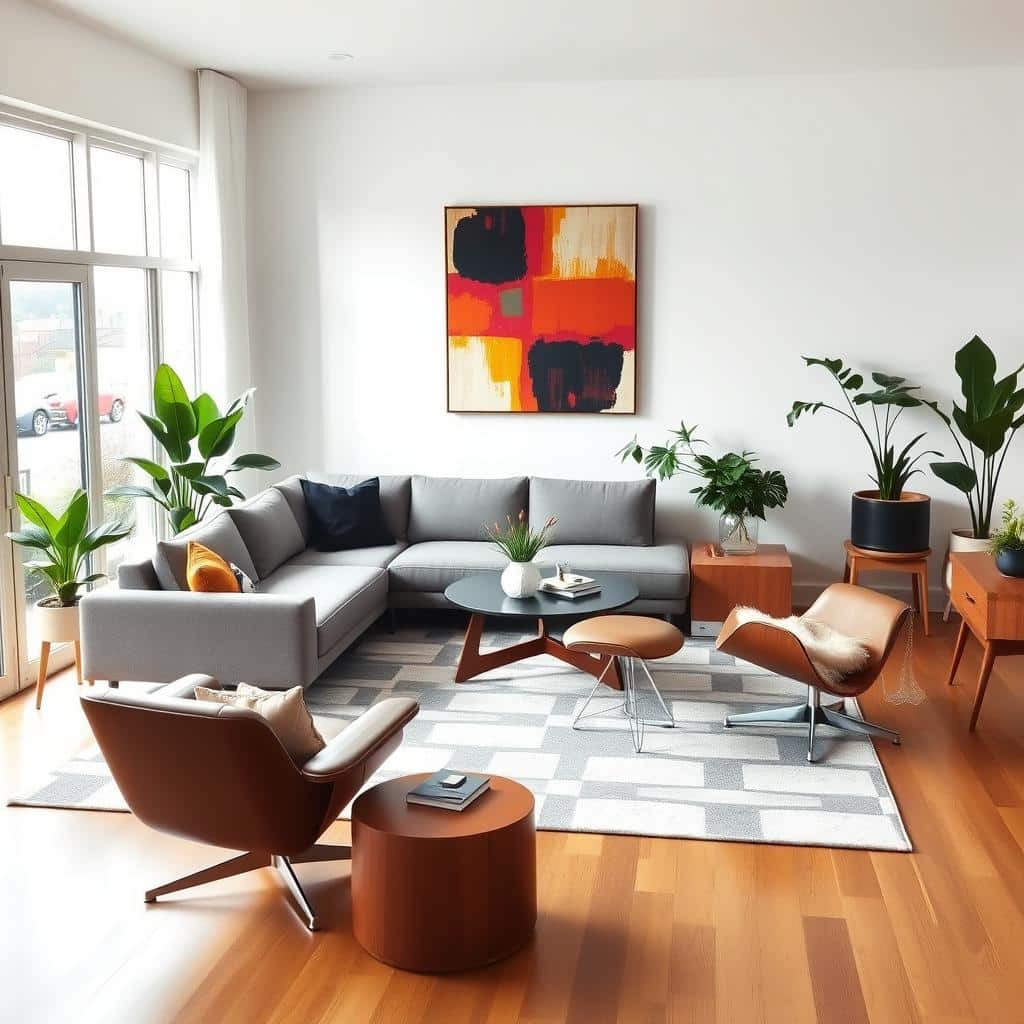
By mixing old and new pieces, using natural materials, and lots of light, you can make your home feel both old and new. This style connects the past and present beautifully. It offers a timeless look that lasts for years.
If you love the classic shapes of mid-century furniture or the bold, geometric patterns, this guide is for you. We’ll dive into what makes mid-century modern interior design so special.
Mid Century Modern: An Introduction
The mid-century modern design movement started in the mid-20th century. It was influenced by the Bauhaus movement and Scandinavian design. This style became very popular in the 1950s and 1960s.
It focuses on functionality, simplicity, and blending with nature. This makes it stand out.
Origins and Evolution
After World War II, there was a big need for new homes and furniture in the United States. This need helped make mid-century modern style popular. Designers and architects were inspired by the Bauhaus idea of “form follows function.”
They created designs that were both innovative and efficient. They used materials like wood, metal, glass, vinyl, and plexiglass in new ways.
Key Principles and Characteristics
Mid-century modern design is known for its clean lines and organic shapes. It values functionality and simplicity. Natural materials like wood, leather, and stone are used, along with bold colors and patterns.
This creates a timeless and striking look. The style is minimalist, focusing on the beauty of each piece. This approach makes each item stand out.
The mid-century modern style is still loved today. It appeals to both homeowners and design fans. Its influence can be seen in modern interior design, like open floor plans and indoor-outdoor living.
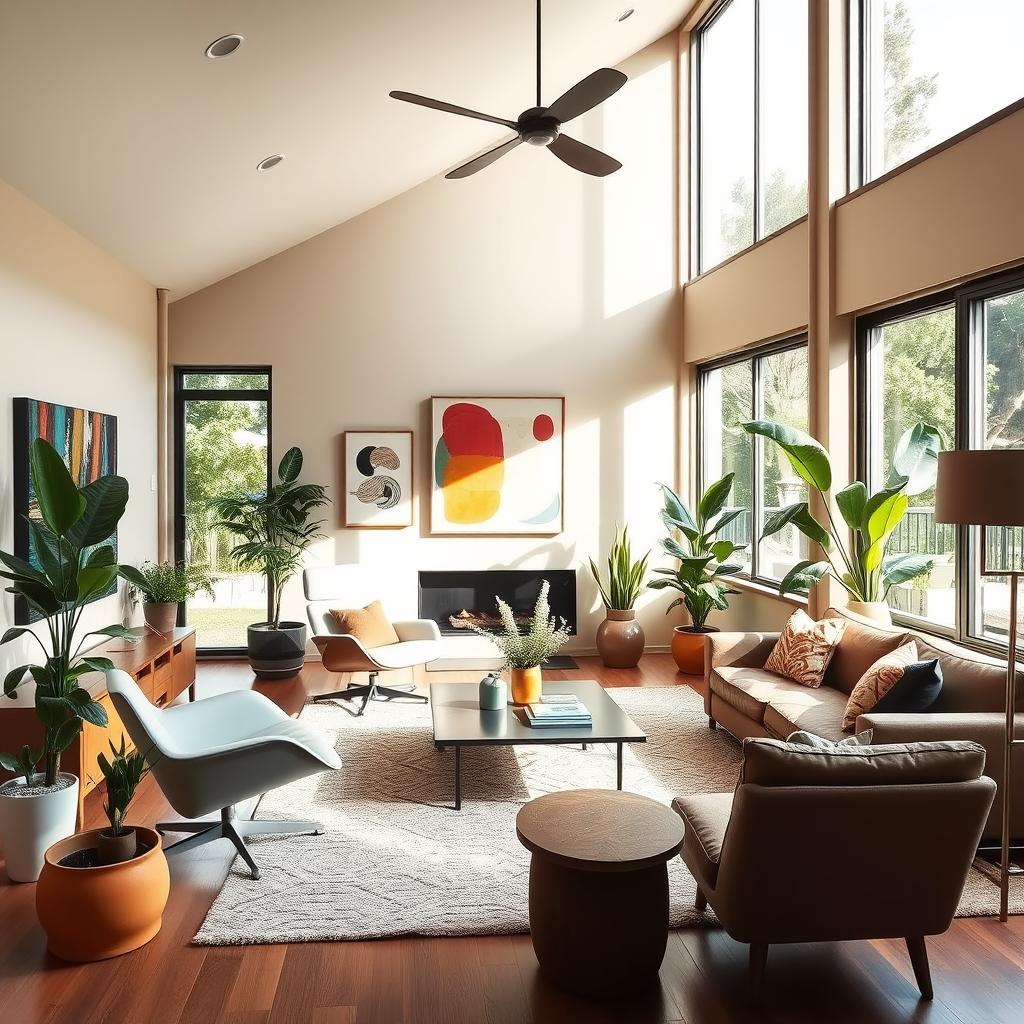
Organic Shapes and Clean Lines
Midcentury modern design focuses on clean lines, simple shapes, and being functional. Shapes like rectangles, circles, and triangles are key. Rectangles are balanced, circles move, and triangles add interest.
Designers also used organic shapes to bring warmth. They worked with materials like wood and plastic. This way, they made pieces that are both beautiful and useful.
| Design Element | Purpose |
|---|---|
| Rectangles | Clean lines and balance |
| Circles | Movement and fluidity |
| Triangles | Accenting visual interest |
| Squares and Cylinders | Versatile furniture and decor elements |
| Organic Forms | Add warmth and naturalness |
The mid-century modern style is all about organic shapes, simple decor, and being practical. By using these elements, you can make a space that looks great and works well.
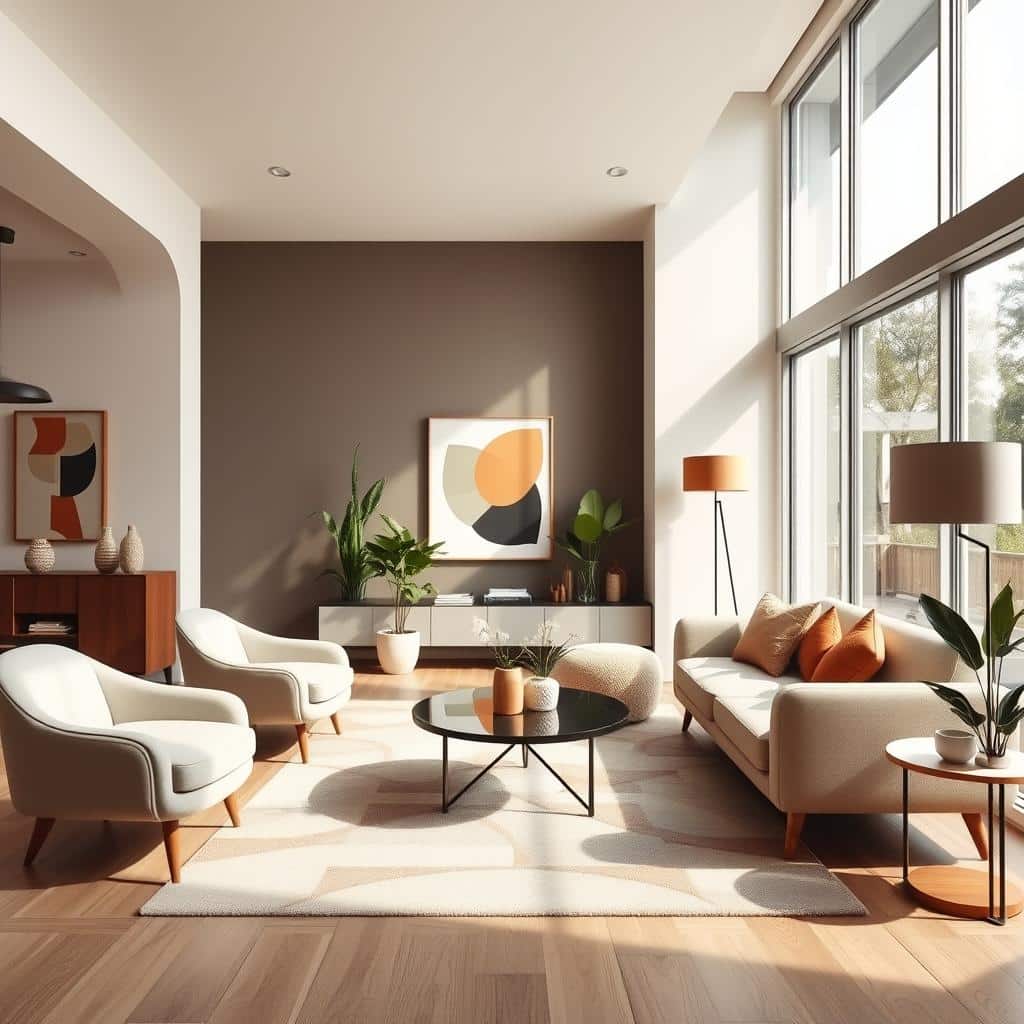
Incorporating Mid-Century Furniture
The mid-century modern design era left a lasting impact on interior design. Its iconic furniture pieces are now seen as timeless classics. The Eames lounge chair and the Saarinen tulip table are key examples. These designs are crucial for anyone wanting to bring mid-century modern style into their home.
Iconic Designs and Silhouettes
Mid-century modern furniture is known for its clean lines and organic shapes. Pieces like the Florence Knoll sofa and the Isamu Noguchi coffee table showcase the movement’s focus on simplicity. Adding these classic designs to your space can make it feel timeless and charming.
Mixing Vintage and Contemporary Pieces
Homeowners can also achieve a mid-century look by mixing vintage and modern pieces. This blend creates an eclectic and visually appealing space. For instance, pairing a vintage Saarinen table with modern chairs or a mid-century sideboard with contemporary art adds a personal touch. It celebrates both the past and the present.
Iconic Mid-Century Modern Furniture Designs
- Florence Knoll Relaxed Sofa by Knoll, Inc.
- Isamu Noguchi Coffee Table
- Ercol Windsor Dining Chairs
- Flos Arco Floor Lamp
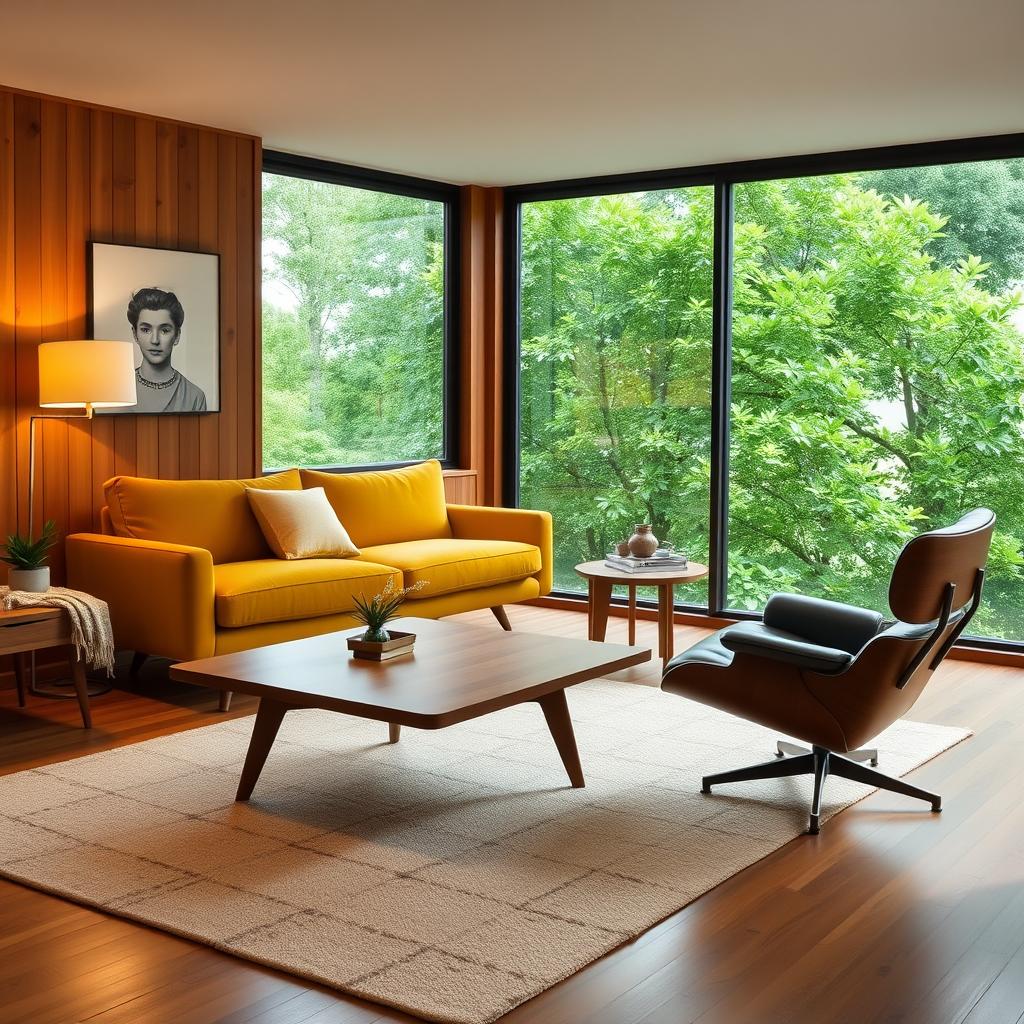
Color Palettes: Earthy Tones and Pops of Color
Mid-century modern design is known for its stunning color palettes. It combines earthy tones with bright pops of color. The colors are inspired by nature, with shades like olive green, mustard yellow, and burnt orange. These colors add a timeless elegance and organic feel to any room.
But mid-century modern design also loves bold, bright colors. Colors like vibrant reds, oranges, and teals are used as accents. They add energy and personality to the space, making it visually striking.
Adding pops of color through textiles, artwork, and accessories can refresh a mid-century modern room. Metallic accents like brass, chrome, or stainless steel add a touch of glamour. This makes the space feel sophisticated and modern.
The secret to a great mid-century modern color palette is finding the right mix. It’s about balancing earthy tones with vibrant colors. By carefully choosing colors, textures, and materials, you can create a space that’s both timeless and engaging. This space will reflect your personal style and lifestyle.
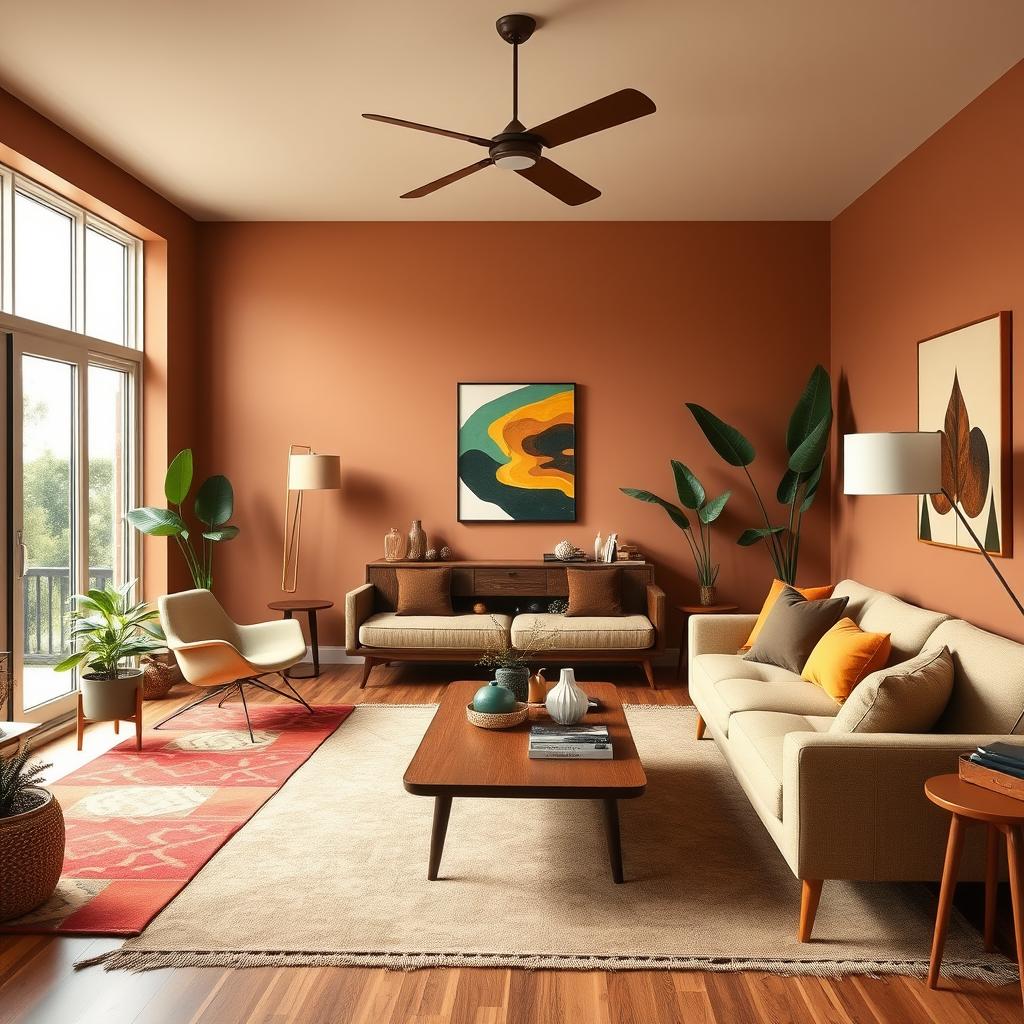
| Color Category | Example Hues | Characteristics |
|---|---|---|
| Earthy Tones | Olive Green, Mustard Yellow, Burnt Orange | Provide warmth, depth, and a natural feel to the space |
| Vibrant Colors | Teal, Red, Orange | Add energy, personality, and visual interest |
| Neutral Foundations | White, Gray, Black | Offer balance and a sense of calm |
Mid Century Modern Interior
The mid-century modern interior style is known for its timeless charm. It emerged in the mid-20th century and is marked by clean lines and open spaces. It also connects indoor and outdoor living seamlessly.
Homeowners can make spaces that are both elegant and modern by following this style. They focus on simplicity, functionality, and a link to nature.
Natural materials, smart lighting, and minimal design are key to mid-century modern interiors. Iconic furniture, like the Eames Lounge Chair, adds to the style’s appeal. The color scheme often includes earthy tones with bright accents for depth.
Mid-century modern homes are known for their open spaces. Large windows and sliding doors bring in lots of natural light. This makes the home feel connected to the outdoors.
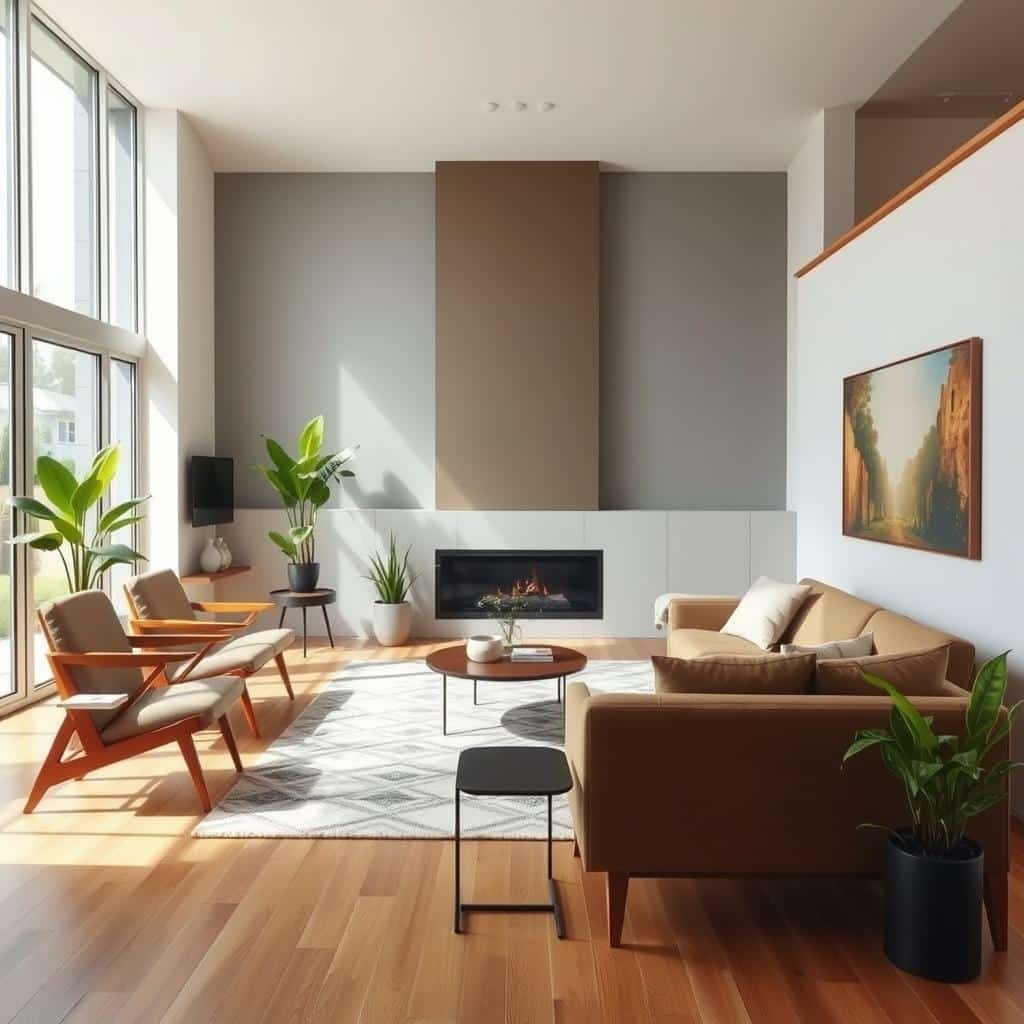
Choosing mid-century modern interior design is a nod to the past and a celebration of timeless beauty. It allows homeowners to create spaces that are both beautiful and practical. These spaces are a mix of nostalgia and modernity.
Blending Materials and Textures
Mid century modern interior design is all about mixing different materials and textures. It celebrates the beauty of wood, leather, and metals. These elements come together to make spaces that are both beautiful and functional.
Think of the warm tones of teak and rosewood furniture. Or the sleek look of brushed brass or chrome. Each piece adds to the overall beauty of the space.
Wood, Leather, and Metallic Accents
Wood is key in mid century modern designs. It’s seen in elegant furniture, striking paneling, or warm hardwood floors. Leather adds a touch of luxury with its timeless appeal.
Metallic elements like brass or chrome add a modern twist. They contrast beautifully with wood and leather, making the space feel fresh and modern.
By mixing these materials, homeowners can create spaces that are both beautiful and interesting. The mix of textures and finishes adds depth and visual appeal. It brings the iconic mid century interior design to life.
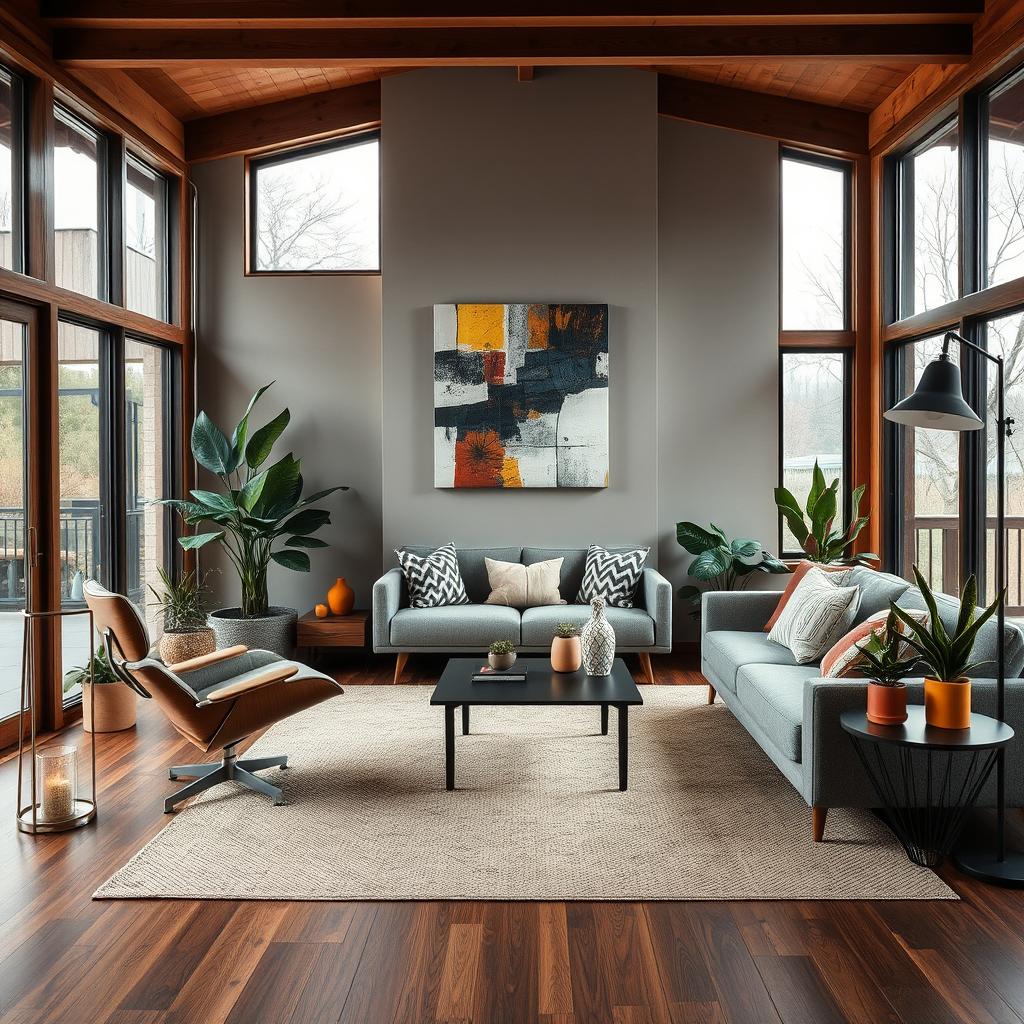
Choosing the right materials is crucial for the mid century modern look. A sleek brass coffee table, a plush leather sofa, or a warm wood-paneled wall can make all the difference. This blend of natural and industrial elements is what makes mid century modern design so timeless and appealing.
Embracing Natural Light
Mid-century modern design loves to blend indoor and outdoor living. It uses lots of natural light. Big windows, sliding glass doors, and open layouts make spaces feel connected.
This light makes rooms feel airy and big. It also highlights the warm colors and natural materials of the interior design mid century modern.
Windows and glass are placed to let light flow freely. This makes the indoors and outdoors feel like one. The mid century modern home interior becomes a living art piece. It changes with light and shadows, creating a unique atmosphere.
Mid-century modern design celebrates the outdoors. It brings sunlight, plants, and nature inside. This makes the mid century modern decor a cozy, peaceful place. It connects us to the world outside.
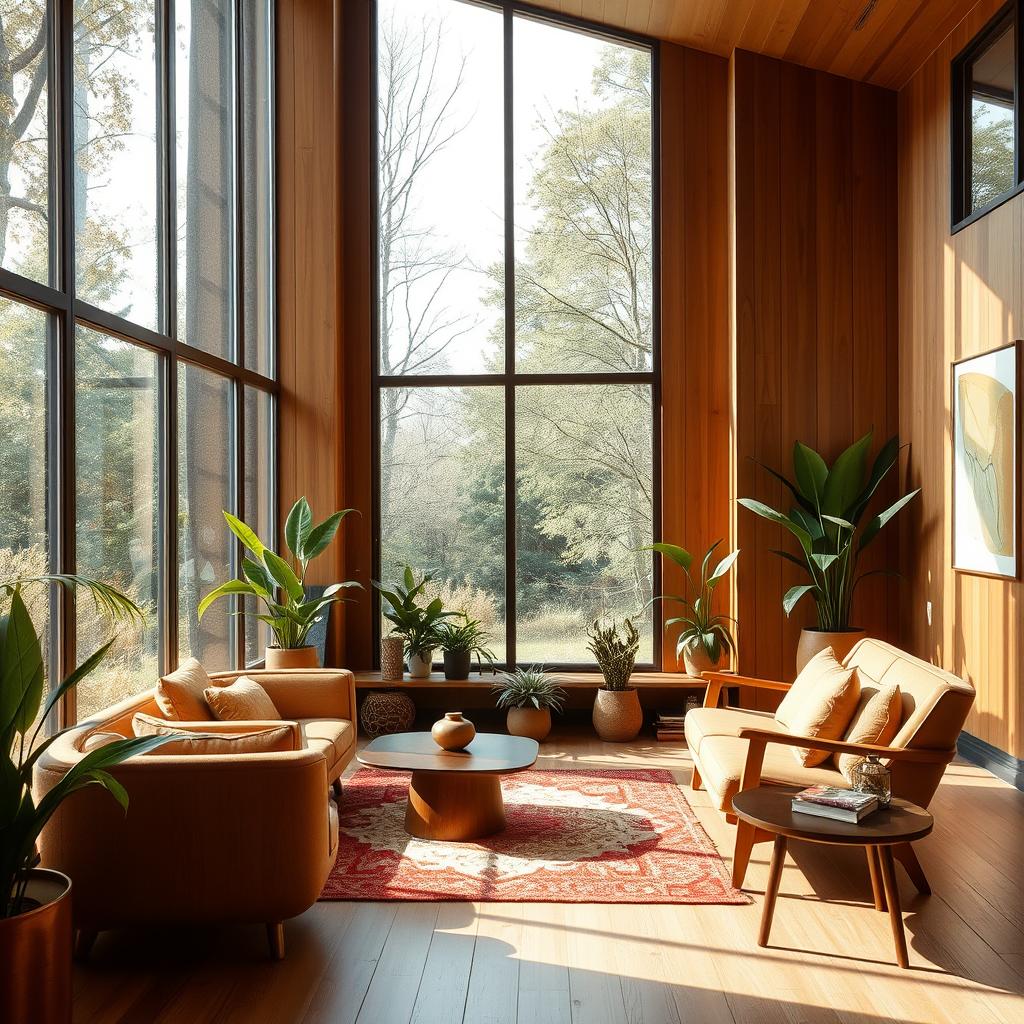
Minimalism and Open Spaces
Mid-century modern design is all about simplicity. It chooses furniture and decor for their usefulness and clean looks. This makes spaces feel open and airy.
The focus is on what works best, not just looks. This way, homes can look modern, elegant, and stylish.
Functional and Uncluttered Aesthetics
Minimalism started in the late 1960s as a way to say no to too much. It fits well with the mid century modern style, valuing open areas and chosen pieces. Every item in a mid-century minimalist space should have a reason to be there.
Using different materials is key to a great mid century modern house interior design. Open spaces highlight the building’s features, not fill them up. Neutral colors and natural materials like wood are often used.
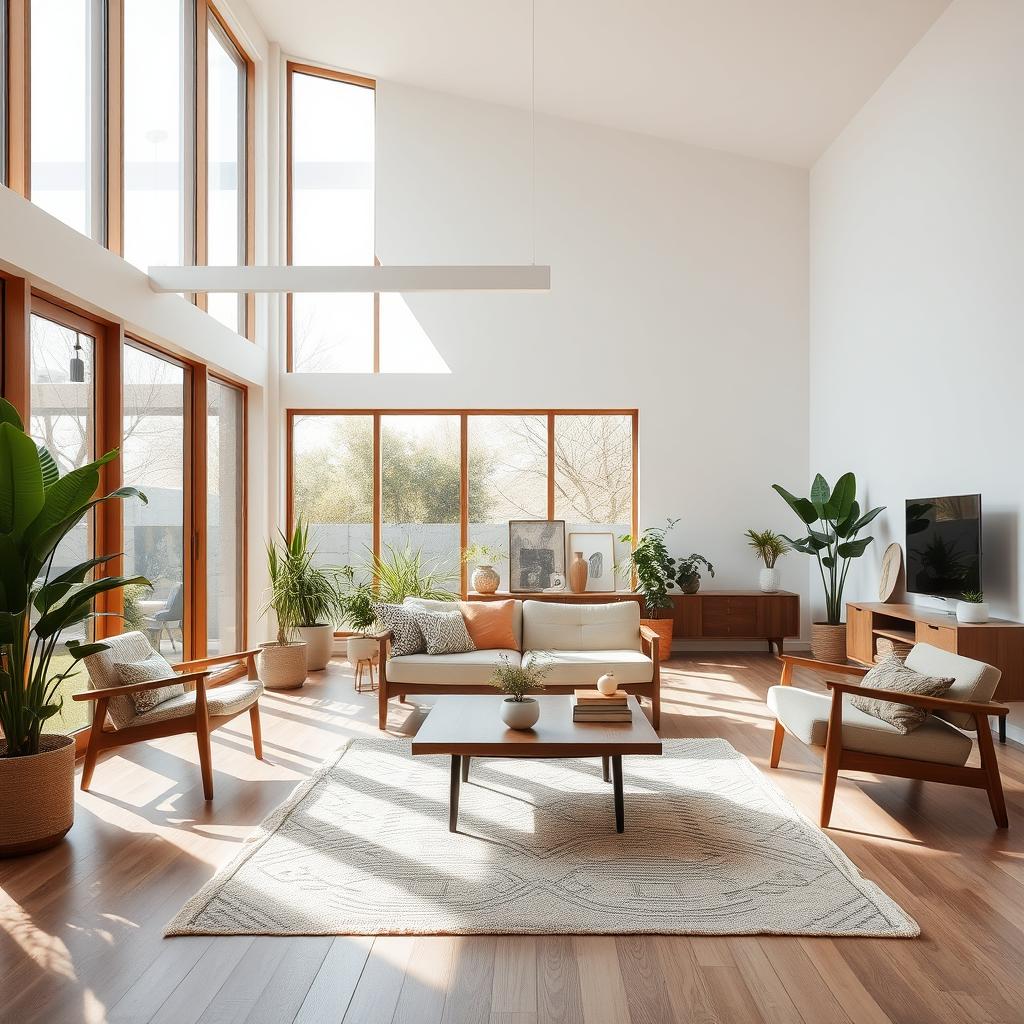
Minimalism and Mid-Century Modern together bring warmth and calm with clean designs. This style is loved for its ability to make peaceful areas in busy lives. It also matches the trend for eco-friendly, thoughtful design.
Mid-Century Modern Lighting
Lighting is key in setting the mood and look of a mid-century modern home. These lights often have sleek shapes that match the style’s clean lines and organic forms.
From eye-catching pendant lights to sleek floor lamps, these fixtures are both useful and stylish. They add to the room’s beauty while also providing enough light for daily tasks.
Lumens offers a wide range of mid-century modern lighting. You can find pendants, wall sconces, and more in finishes like black, brass, and white. This variety helps match different tastes and decor.
- Pendants
- Wall Sconces
- Flush Mounts
- Chandeliers
- Table Lamps
Choosing the right mid-century modern lighting can make your home look great and work well. These lights fit many styles, making them perfect for any room.
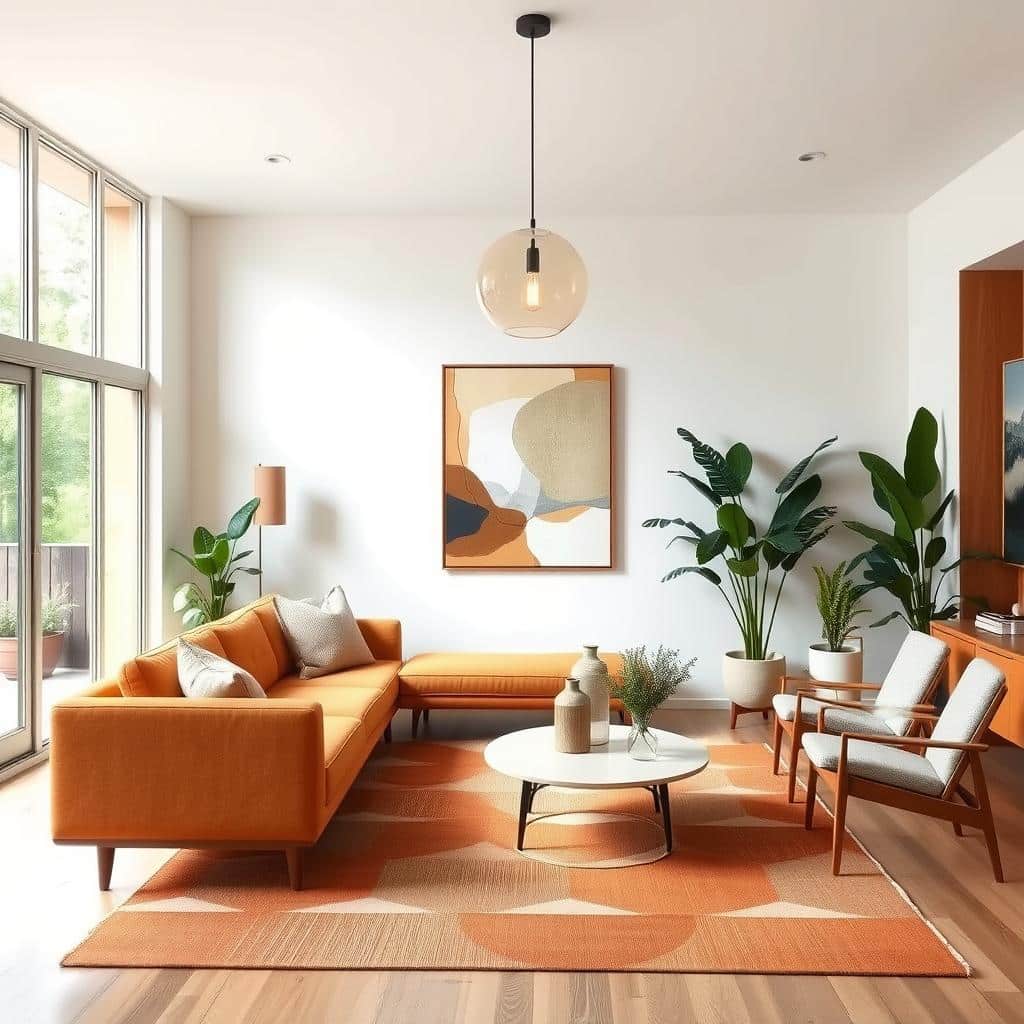
Incorporating Art and Decor
Mid-century modern interiors use art and decor to add personality and interest. Bold abstract paintings or sculptural vases can be focal points. Accessories like geometric rugs or vintage ceramics add texture and color.
Statement Pieces and Focal Points
To get the mid-century modern look, homeowners can use bold art pieces as focal points. These can be large abstract paintings or sculptural floor vases. They draw the eye and anchor the room’s design.
Choosing art that fits the mid-century modern design philosophy helps create cohesive interiors. This makes the space visually engaging.
- Abstract paintings with bold, geometric shapes
- Sculptural floor vases or ceramics
- Vintage-inspired light fixtures or chandeliers
- Geometric-patterned area rugs or textiles
| Design Element | Iconic Mid-Century Modern Examples |
|---|---|
| Art | Abstract paintings by artists like Alexander Calder, Joan Miró, and Frank Stella |
| Accessories | Ceramic vases and sculptures by Eero Saarinen, George Nelson, and Isamu Noguchi |
| Lighting | Bubble lamps by George Nelson and Sputnik chandeliers by Gino Sarfatti |
| Textiles | Geometric-patterned rugs and upholstery by Alexander Girard and Marimekko |
By choosing art and decor that fits the mid-century modern style, homeowners can create stunning interiors. These spaces showcase personal style and the timeless beauty of this iconic design movement.
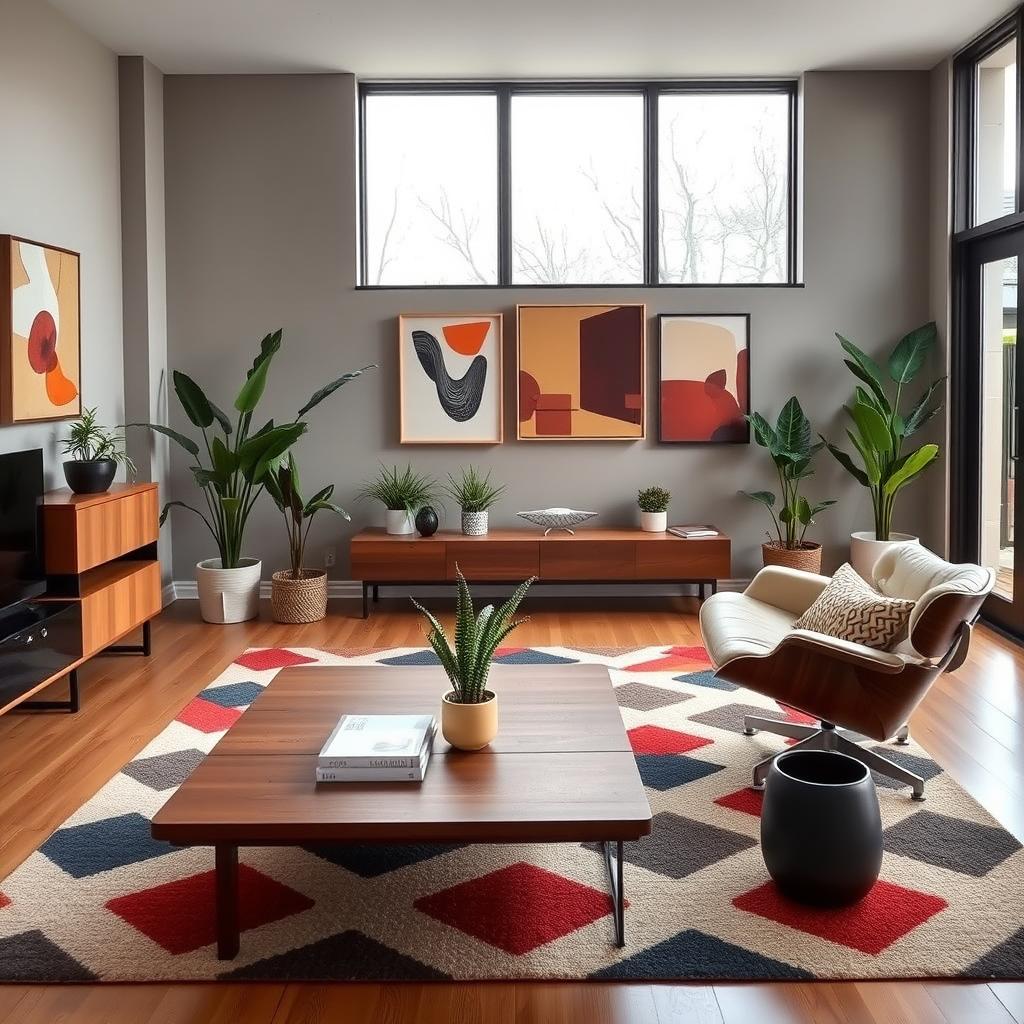
Indoor-Outdoor Living Spaces
The mid-century modern design focuses on blending indoor and outdoor spaces. Large windows and sliding glass doors make rooms feel bigger. This design uses natural materials and plants to connect with nature.
Homeowners can make their homes feel welcoming and open. This approach lets people enjoy the outdoors right from their living room.
Mid-century modern designs suit many climates and lifestyles. By blending indoors and outdoors, homes become more connected to nature.
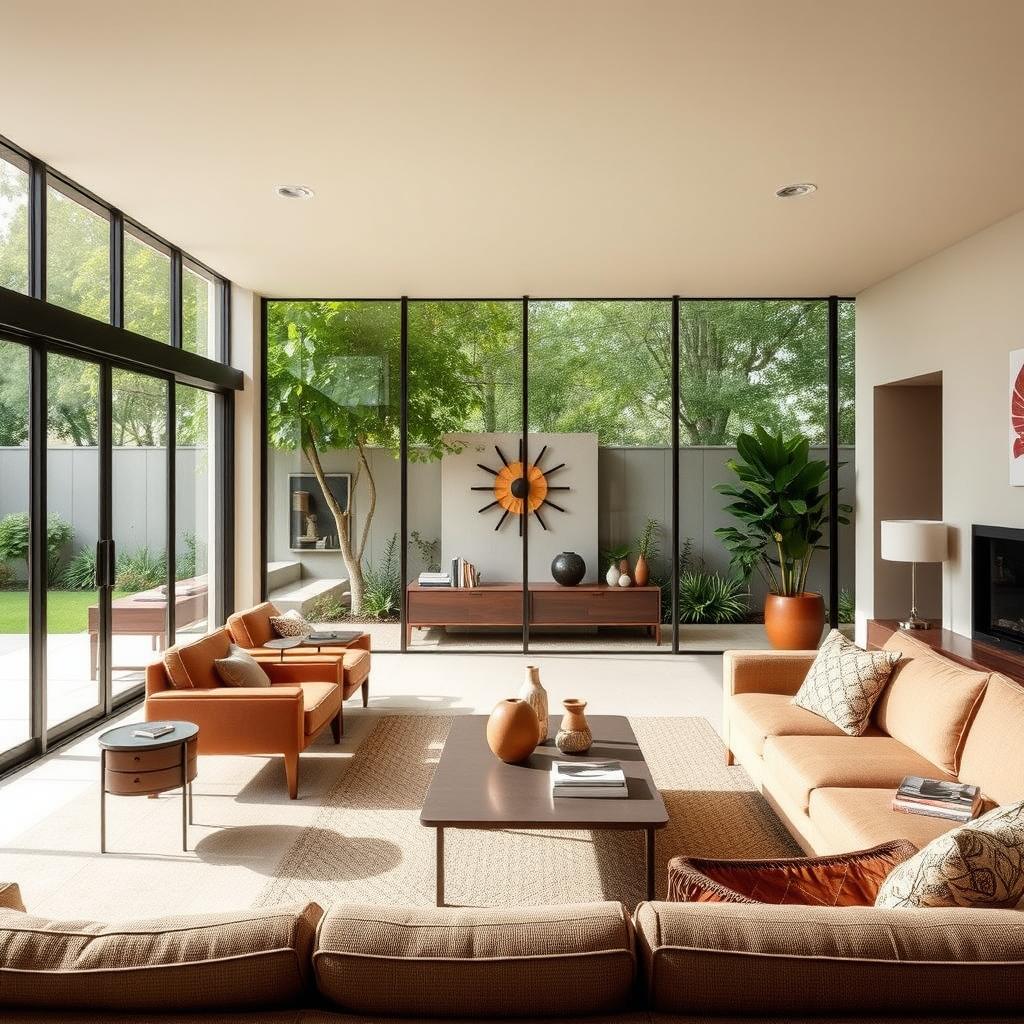
Regional Influences and Variations
The mid-century modern interior design style has grown and changed over time. In the United States, it’s linked to California’s Palm Springs for its sleek look. The Pacific Northwest is known for its warm, natural materials.
Scandinavian mid-century modern interior design stands out for its simple, functional style. It focuses on light and airy spaces. Homeowners can use these ideas to make mid-century modern interiors that are unique and personal.
The mid-century modern design movement lasted from 1945 to 1970. It was big in the United States, Mexico, Brazil, and Europe. Since the late 1990s, it has become popular again, recognized by scholars and museums worldwide.
In the United States, mid-century modern architecture was influenced by the International and Bauhaus movements. It aimed for simplicity and blending with nature. Palm Springs, California, is famous for its mid-century modern architecture.
Brazil has Brasília, a city built entirely in the mid-century modern style, inaugurated in 1961. Architects like Lucio Costa, Vilanova Artigas, and Oscar Niemeyer shaped Brazil’s mid-century modern architecture. Their work includes the Cathedral of Brasília and the National Congress of Brazil.
Despite regional differences, mid-century modern interior design is a global phenomenon. It has a timeless appeal, inspiring architects, designers, and homeowners worldwide.
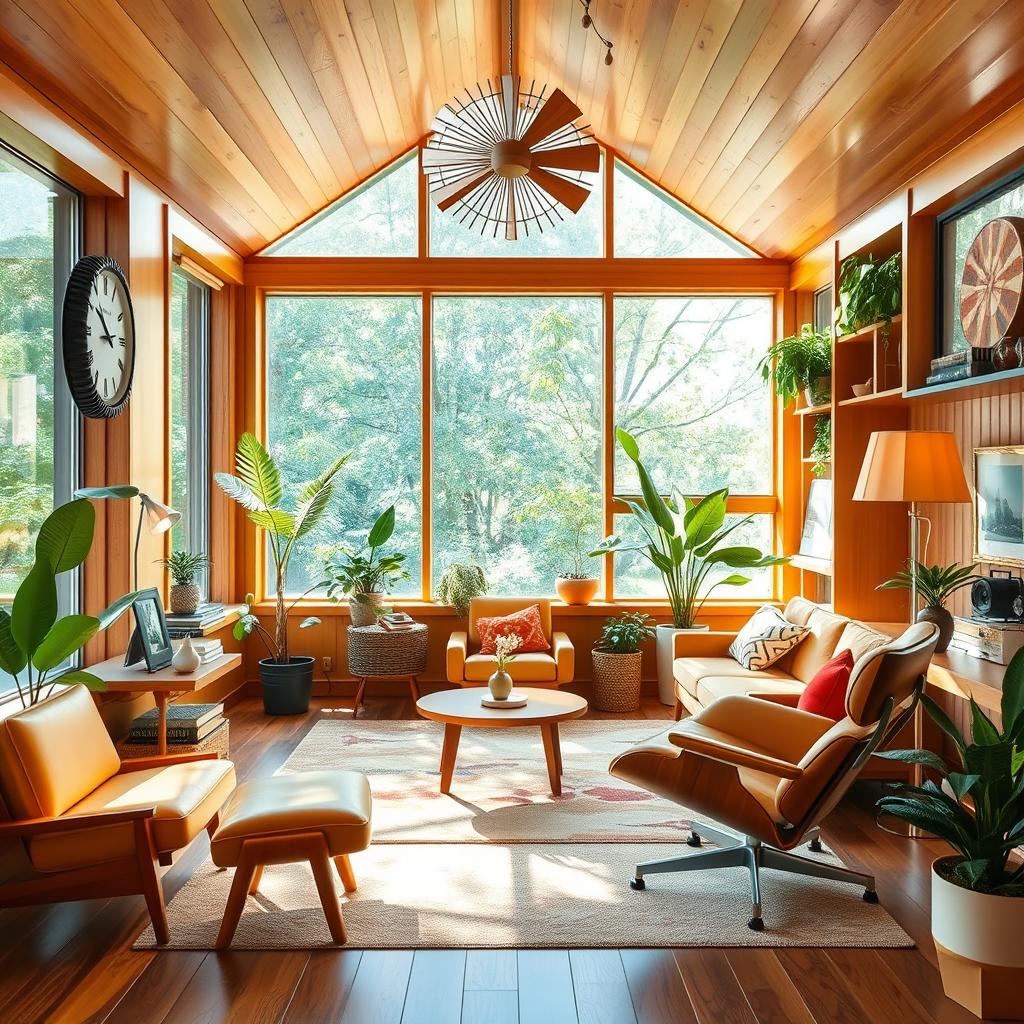
| Region | Key Characteristics | Notable Architects/Designers |
|---|---|---|
| United States | Sleek, geometric architecture; warm, natural materials | William F. Cody, Albert Frey, A. Quincy Jones, John Lautner, Donald Wexler, E. Stewart Williams |
| Scandinavia | Minimalist, functional approach; emphasis on light and airy spaces | Arne Jacobsen |
| Brazil | Entire city of Brasília built in mid-century modern style | Lucio Costa, Vilanova Artigas, Oscar Niemeyer |
Conclusion
The mid century modern interior design is loved for its lasting beauty. It combines clean lines, organic shapes, and indoor-outdoor living. This style makes homes both stylish and functional.
Homeowners can choose from California’s sleek designs or Scandinavian’s warm tones. The mid century modern style is perfect for those who want a modern yet classic look.
By using iconic mid century modern interior design pieces, homeowners can make their homes inviting. They can mix natural materials and lighting with bold colors. This creates spaces that are both beautiful and timeless.
The midcentury modern interior design is becoming more popular. It offers a way to blend old and new in home decor. This allows homeowners to create spaces that are both unique and harmonious.
The beauty of mid century modern interior design comes from its focus on function and simplicity. It also values the natural world. By following these principles, homeowners can make spaces that are both modern and timeless.
FAQ
What is mid-century modern interior design?
Mid-century modern interior design is a style from the mid-20th century. It’s known for clean lines, organic shapes, and natural materials. It also focuses on functionality and minimalism.
What are the key principles of mid-century modern design?
Mid-century modern design uses organic shapes and clean lines. It also includes natural materials like wood and leather. The goal is to create open, uncluttered spaces that blend indoor and outdoor living.
How can I incorporate mid-century modern design elements into my home?
To add mid-century modern style to your home, look for furniture with sleek lines and natural materials. Use vibrant colors and open floor plans. Embrace natural light and a minimalist approach for a cohesive look.
What are some iconic mid-century modern furniture pieces?
Iconic pieces include the Eames lounge chair and the Saarinen tulip table. The Barcelona chair is also a classic. These pieces are key to achieving the mid-century modern look.
How do I mix vintage and contemporary pieces in a mid-century modern interior?
Mixing vintage and modern pieces creates a unique interior. Find a balance between old and new. Use natural materials and clean lines to tie the space together.
What color palette is typical of mid-century modern design?
Mid-century modern design often uses warm, natural tones. Think mustard yellow, olive green, and orange. These bold colors are balanced with softer shades for a striking look.
How can I incorporate natural materials in a mid-century modern interior?
Mid-century modern design celebrates natural materials. Use wood, leather, and metallic accents for texture and interest. Layering these materials creates a cohesive look.
What role does lighting play in mid-century modern design?
Lighting is key in mid-century modern design. Sleek, sculptural fixtures add function and style. Look for clean, geometric shapes in lighting to enhance the overall aesthetic.
How can I incorporate art and decor into a mid-century modern space?
Art and decor add personality to mid-century modern spaces. Use statement pieces like bold paintings or sculptural vases. Accessories help add texture, color, and character.
How do regional influences impact mid-century modern design?
Mid-century modern design has evolved with regional influences. For example, California’s Palm Springs is known for sleek architecture. The Pacific Northwest is famous for warm, natural materials. These influences shape the style.
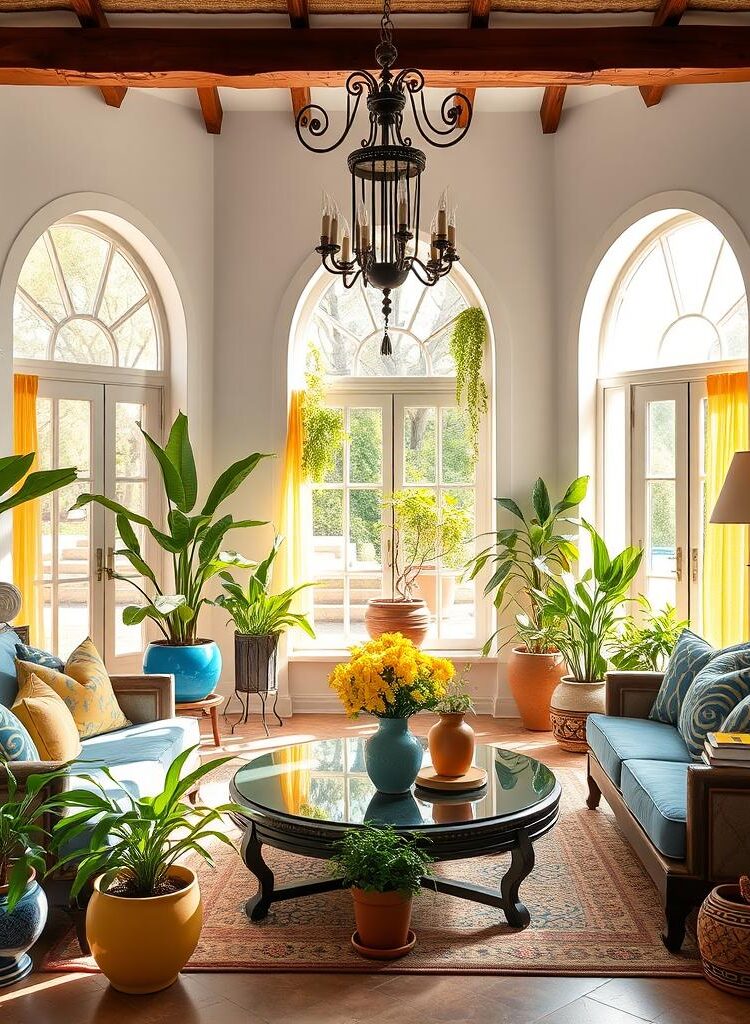
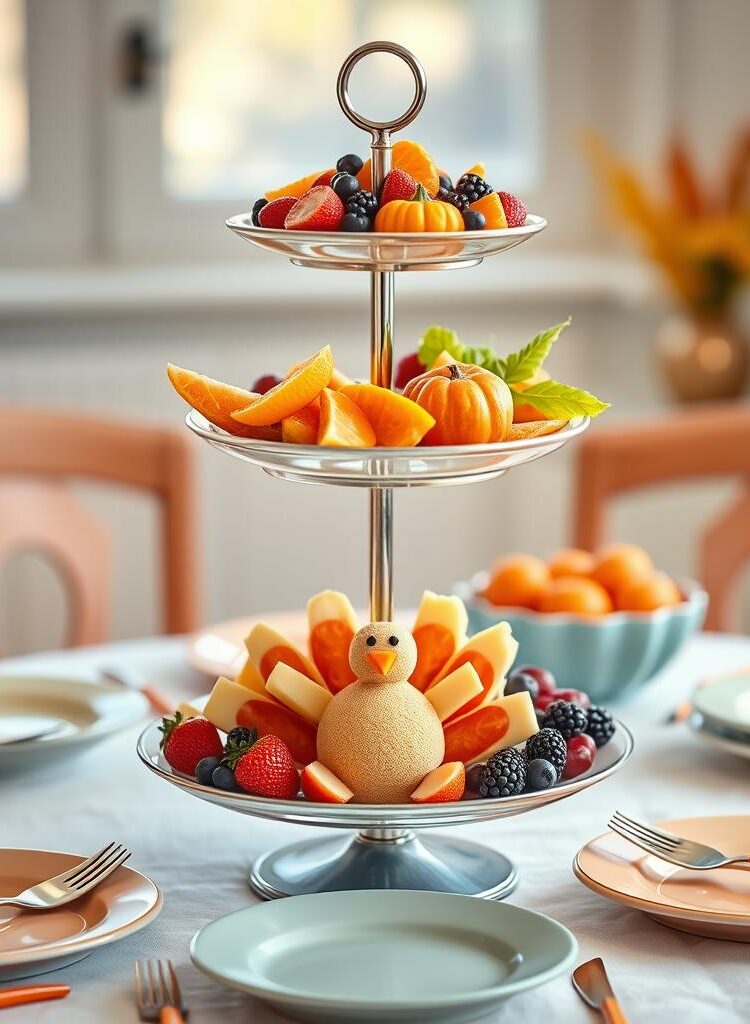
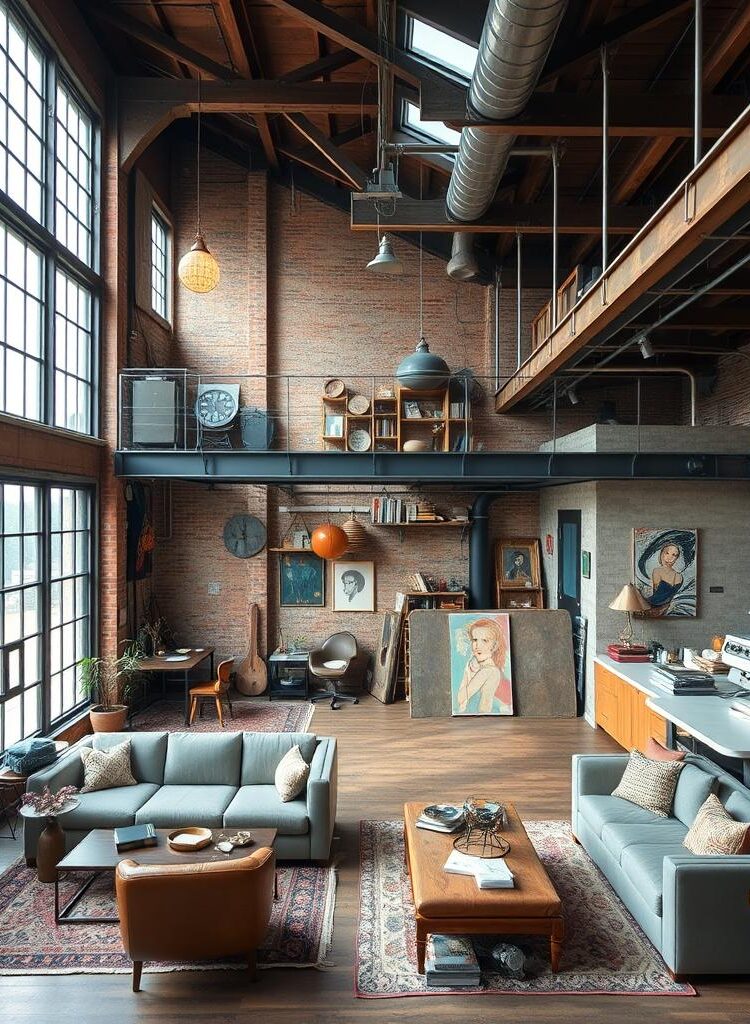
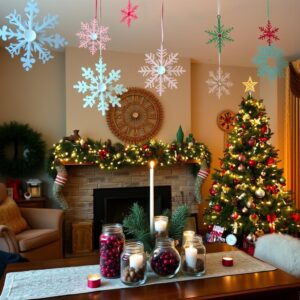
Leave a Reply